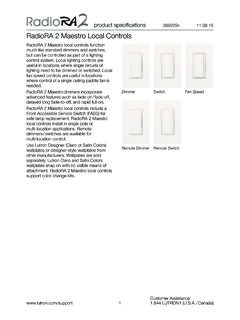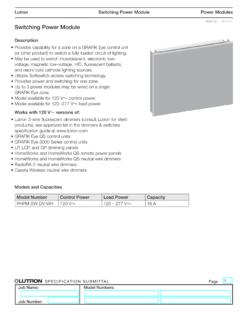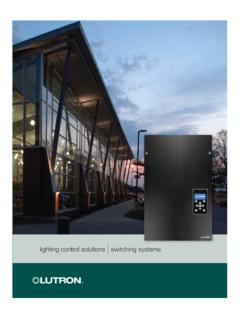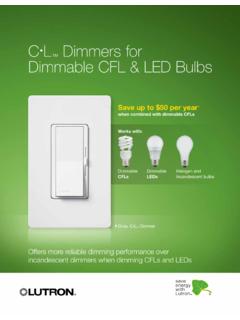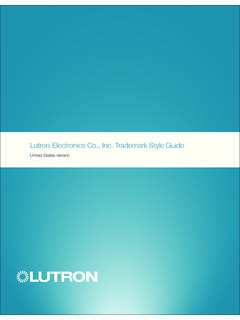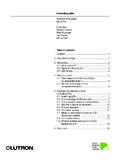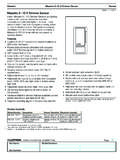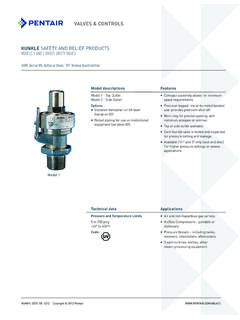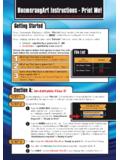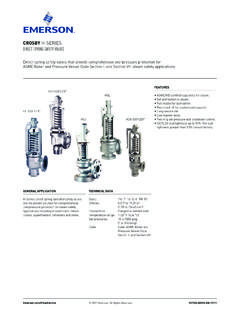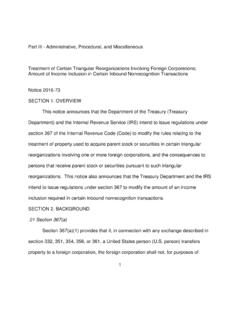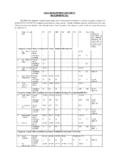Transcription of Daylight Sensor Design and Application Guide
1 Daylight SensorDesign and Application GuideD | LutronDaylight Sensor | Design and Application GuideVocabularyDaylight Harvesting: The term used in the building controls industry for a control system that reduces electric light in building interiors when Daylight is available, in order to reduce energy Row: A group of fixtures adjusted equally based on daylighting readingsDaylight Sensor : A device that reads available light and sends a signal to the control system. Daylight Sensor = Photo Cell = Photo SensorMultiple Row Daylighting: A form of daylighting in which multiple Daylight rows are controlled by the same Sensor . Each row is calibrated to provide a balanced amount of light throughout the Surface Light Level: The light level measured in FC using a light meter at the work surface. If cubicle walls are in use then this value is measured at the cubicle Light Level: The target work surface light Setpoint (TSP): The specified electric light level when there is no Daylight entering the space.
2 Also known as the Nighttime Target : A specified light level that is required to turn electric lights ON or OFF. Specified light levels represent the lights levels at which an action will occur in the system. This applies to switching/non-dim : The numeric value set during calibration that determines how aggressive the daylighting is. The higher the gain, the more the lights will Feedback: Light from a fixture shining directly onto a Daylight Sensor and causing the system to behave unexpectedly. Based on the Electric Light Contribution (ELC) on the photo Sensor from the surrounding fixtures. Sometimes known as electric light Light Level: The method of daylighting through cutting off all zones above the daylighting level and leaving other zones unaffected. This cutoff point can be changed throughout the space using multi-row daylighting.
3 Table of contents1 Dayliglht harvesting3 Daylight Sensor benefits4 Codes and standards4 Different daylighting methods8 Different types of daylighting11 Sensor placement guidelines16 Fixture feedback19 Special considerations20 Wireless Daylight sensor21 Wired Daylight sensorLutron | 1 Daylight harvestingDaylight harvesting, which takes advantage of naturally available light, is a key energy-saving strategy for commercial spaces. The principle is simple: the electric lights in a space can automatically be dimmed downed or turned off when enough natural light is entering the to the Department of Energy, lighting accounts for an average of 38% of electricity usage in commercial buildings, more than any other building system. When seeking a dramatic reduction in electricity costs, one would be well advised to start with the lights. A thoughtfully deployed Daylight harvesting program for building lighting can typically deliver energy savings of 20-60%, while providing the assurance that occupants have the right amount of light in the electricity use in commercial buildings1 LightingOffice EquipmentOther0510152025303540 HVAC38%26%7%29%1 Energy Information Administration, released September 2008.
4 2003 Commercial Building Energy Consumption Survey (CBECS)2 Brambley MR, et al. 2005. Advanced sensors and controls for building applications: Market assessment and potential R&D pathways. Pacific Northwest National Laboratory: prepared for Department of OnDimDaylight Harvesting dims electric lights or switches them off during the day to take advantage of available 60% Light Savings22 | LutronDaylight Sensor | Design and Application GuideLutron | 3 Daylight Sensor benefits Saves energy Reduces energy consumption by dimming or turning off electric lights based on the natural Daylight entering the space Can deliver up to 60% lighting energy savings in some areas2 Provides comfort and convenience Helps maintain the proper light level for a space, so a space is never too dark or too bright Continuously adjusts lights automatically so occupants don t have to manually adjust them as Daylight levels change.
5 Meets codes and standards Meets the mandatory requirements set for building construction and renovation Can contribute to obtaining points in several LEED credit categories Codes and standards that may applyLEED up to 19 pointsDaylight sensors can contribute up to 19 possible points in the LEED 2009 NC rating 2010 (energy standard for commercial buildings)Parking Garage Lighting Control ( )Transition lighting and lights within certain parameters with relation to natural light must be automatically reduced in response to Daylighting Controls for Sidelighted Areas ( )The lamps for general lighting must be controlled by at least one multilevel Daylight control in any enclosed space that has more than 250 ft2 of window lit Daylighting Controls for Toplighted Areas ( 5)The lamps for general lighting must be controlled by at least one multilevel Daylight control in any enclosed space that has more than 900 ft2 of skylight lit Lighting Control ( )Exterior lighting must automatically be turned off when sufficient Daylight is 24 2013 Part 6 (California s energy standard)SECTION Indoor Lighting Controls That Shall Be Installed(d) Automatic daylighting controlsAutomatic daylighting controls must be used to provide multi-level or continuous dimming in spaces with more than 250 ft2 of Daylight 2012 (International Energy Conservation Code) Daylight Zone Control ( )Multiple Daylight zones must be separately controlled from the general area lighting and can be controlled either manually or via an automatic Daylight 2012 (International Green Construction Code)Automatic Daylight Controls ( )
6 Automatic Daylight controls shall be provided for all Daylight summaries are meant as a general reference of some of the mandatory requirements that Daylight sensors help meet. They may or may not apply to your project. Please refer to your local building energy code or authority having jurisdiction for your precise | LutronDaylight Sensor | Design and Application GuideA sample private office closed loop Sensor setup.*A sample private office open loop Sensor setup.* Lutron | 5 Different daylighting methods Closed loop Closed loop is an approach to daylighting that attempts to keep the illumination at the Sensor constant. This approach is task oriented; the Sensor looks directly into the space of the light that it controls. Sensors placed inside the space, typically directly above work surface dependent on Sensor instructions Measures light level in a narrow viewing angle Adjusts electric light level up or down to maintain a desired light level on the work surface Affected by both electric light and Daylight For accurate performance the Sensor can only control fixtures that are contributing to the field of view Generally one Sensor per task surface Customer would have to buy far more sensors to cover the same area The Sensor cannot distinguish between Daylight fluctuations and changes of surface reflectance Open loop In this approach to daylighting, the illumination at the Daylight Sensor varies.
7 It has a wide field of view; the Sensor doesn t look directly into the space that contains the lights that it controls. Measures Daylight only Wide field of view Often placed outside the space Does not take into account window treatments* NOTE: Dotted lines are for visualization purposes only6 | LutronDaylight Sensor | Design and Application GuideAn example of a Lutron daylighting system.* Partial open loop Lutron approach In partial open loop daylighting, sensors are positioned inside the physical space and take into account the light levels penetrating the area from natural light sources, as well as light contributions from the work surface. This approach combines both open and closed loop methods. Single Sensor can control multiple rows Takes into account light level actually entering into the space, accounting for window treatments and natural weather conditions Not significantly affected by reflectance from the surface below Does not need to be placed directly above the task surface* NOTE: Dotted lines are for visualization purposes only Lutron | 7 How does partial open loop daylighting work?
8 The two main variables that define the behavior of a system are target setpoint (TSP) and gain. All of Lutron s systems use TSP and gain to determine how the Sensor reading affects the artificial light in a space. The values are determined during initial set up. Based on which system is being used, one or both of the variables may then be adjusted to allow additional tuning. Target setpoint (%)This setting determines the ballast light level when the Daylight Sensor is reading way to think about it is TSP is the percentage the ballasts will go to at HIGHER the TSP, the HIGHER the electric light adjustmentGain determines how much the lights will dim when Daylight is you have a high gain, the lights will be more affected by the current Daylight Sensor readings, so electric light output will be HIGHER the gain the LOWER the electric light | LutronDaylight Sensor | Design and Application GuideDifferent types of daylightingSwitched daylightingIn switched daylighting, loads are turned off when the Daylight meets a minimum desired level.
9 This type of daylighting uses a delay-to-off and hysteresis in order to prevent frequent on-off the chart below, the electric lights have been designed to supply the desired amount of light at desk height. You can see as the sun rises the total light in the space increases. Once the Daylight entering the space is enough to exceed the minimum required light level (with a built-in hysteresis), the electric lights will turn off. The electric lights will then remain off until the point in the day at which the natural light can no longer provide the minimum required light level in the of the downsides of switched daylighting is that the space is over lit just before there s enough Daylight the space to provide the minimum required light | 9Bi-level daylightingBi-level daylighting is very similar to switched daylighting, but with the addition of a 50% light level.
10 Electric lighting to the left will move from 100% to 50% to off as the Daylight becomes more abundant. In the chart below, you can see how the electric light contribution in the space is additive to the Daylight entering the space. As the total light in the space increases, the electric lights will dim to 50%. They ll turn off once the Daylight entering the space is enough to provide the minimum required light level for the space. The bi-level, or 50% level, helps avoid having the space be over lit before there s enough Daylight to provide the minimum required amount of | LutronDaylight Sensor | Design and Application GuideContinuous daylightingContinuous daylighting involves smooth, continuous dimming from low end to high end in order to maintain the desired light level. Continuous daylighting adjusts lights based on the amount of Daylight that s always in the space, ensuring that the minimum light level is achieved without over-lighting the space (as in switched and bi-level daylighting).
